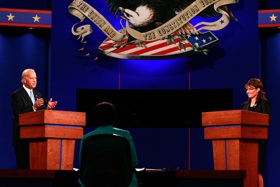Study shows Palin treated differently by media as vice presidential candidate than Biden
The 2008 presidential race was one of the most watched, discussed and analyzed campaigns in U.S. history, and when it came to the vice presidential candidates, voters heard a great deal about Sarah Palin.
Much more, in fact, than they heard about her opponent, Joe Biden.

New research analyzes media coverage of the 2008 vice presidential candidates.
News coverage of Palin, then the Republican governor of Alaska, not only significantly outweighed that received by Biden, then a U.S. senator from Delaware, was markedly different in substance and across media, according to a new study of media coverage of the vice presidential candidates.
Coverage of Palin was more likely to include references to her family, physical appearance and social issues, particularly in newspapers and by political blogs, while coverage of Biden dealt more with foreign policy and the economy.
“Each of these differences could have had important influences on public opinion formation and the public’s voting decisions in this particular race,” write Leticia Bode, a former graduate student at the University of Wisconsin–Madison who is now an assistant professor at Georgetown University, and Valerie M. Hennings, an assistant professor at Iowa State University, in the study published in the journal Politics & Policy. She conducted the research while at UW–Madison.
“Without an examination of vice presidential contests, our understanding of the intersection of political communication and the experience of women as political candidates is incomplete,” Bode and Hennings write. “If gender stereotypes in media coverage have the ability to negatively affect women candidates, this calls into question the American political system’s ability to produce elected representatives in a fair and democratic manner.”
Bode and Hennings tested three theories: The amount of coverage Palin received was greater than Biden; gender stereotypes would be reflected in the substance of coverage and emerge on such issues as family, electability, policy issues and physical appearance; and the amount and substance of coverage Palin and Biden received would differ across media.
They performed a content analysis that included coverage from Aug. 16 to Nov. 11, 2008, the period just before the Democratic National Convention to the week after the general election. News coverage mentioning the candidates was gleaned from the New York Times, the Washington Post and USA Today; transcripts from the three major broadcast networks’ evening broadcasts, as well as the equivalent periods on CNN and Fox News; and entries on nearly 400 political blogs.
The research showed that the vice presidential race in 2008 was in itself unique because of the attention it received. Discussion about McCain selecting Palin accounted for 7 percent of all television election coverage of the 2008 campaign, while the debate between Palin and Biden was the most-watched vice presidential debate in U.S. history, attracting nearly 70 million viewers.
In addition, the authors said, the race was especially novel because of Palin’s selection as the first woman on a Republican presidential ticket.
The high level of interest in her candidacy was reflected in the volume of coverage that went her way. The authors found that the average number of stories a day in overall coverage was 36 for Palin, compared with 14.9 for Biden. On television, Palin was the subject of 8.8 stories a day compared with 4.6 for Biden; in newspapers, it was 15 compared with 8.2 stories a day, and on political blogs, 14.2 compared with 3.2 stories a day.
In that coverage, the authors found evidence of gender stereotypes, with stories mentioning her family, physical appearance and positions on social issues; this trend was more pronounced on television. However, on issues that might be considered “women’s issues,” such as health care or education, Biden received more coverage.
“Each of these differences could have had important influences on public opinion formation and the public’s voting decisions in this particular race,” the authors write. “If future research finds similar differences in coverage in other races, the implications could significantly affect the election process, particularly for female candidates.”

